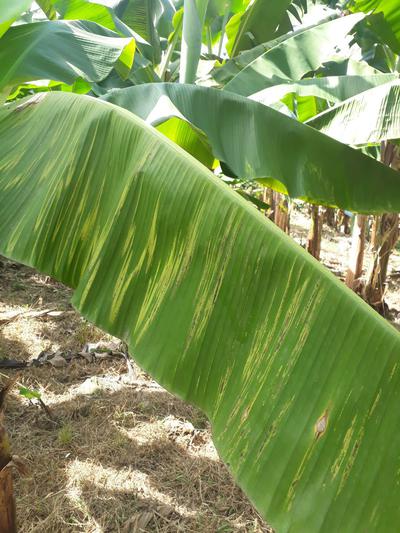Cucumber Mosaic Virus on Banana
CMV
Virus
In a Nutshell
- Patterns of light and dark green mottles and mosaics on the leaves.
- Infected fruits may appear smaller in size and may show chlorotic lines or necrosis.
Can also be found in
Symptoms
The infection can occur at any growth stage of the tree and is mainly visible on leaves. Initial symptoms are mosaic-like patterns of continuous or interrupted streaks parallel to the veins. The leaves may acquire a stripped look. Over time, the leaf lamina does not develop completely and the margins appear irregularly curved and may show necrotic spots. The young leaves may be reduced in size, too. Rotten areas may appear on the leaf sheaths and spread further to pseudostems and the bulb. Older leaves show signs of necrosis as black or purple lines and drop off. Infected plant are not able to mature and may be unable to produce bunches. The fruits do not always show symptoms but they usually appear smaller in size and have chlorotic lines or necrosis on them.
Recommendations

Organic Control
Direct treatment of viral diseases is not possible, but it is possible to reduce the risk of infection via aphids. There are different natural enemies that can be used effectively against aphid species such as parasitoid, parasitic or predatory insects and fungi species. A dry heat treatment of root suckers at 40°C for one day may also help to reduce the risk of infection.

Chemical Control
Always consider an integrated approach with preventive measures together with biological treatments if available. Direct treatment of viral diseases is not possible, but alternative hosts and vectors can be controlled to a certain degree. If insecticides are needed, products containing demeton-methyl, dimethoat and malathion can be used as foliar spray applications. Please bear in mind that the listed chemicals have a toxic to very toxic impact on human health as well as on animals.
What caused it?
The symptom are caused by a virus. The primary infection usually occurs through infested plant material such as root suckers used as transplants. Aphid species serve as vectors for secondary infection and spread the virus particles to other plants or fields. Cucumber and tomato are dormant host plants for the virus, that is they can harbor the viral particles without developing any symptoms. The infection is favored by specific weather conditions such as frequent rainfalls, for example during the late and post monsoon periods. The disease is a serious treat to banana plants and may lead to heavy yield losses.
Preventive Measures
- Comply with strict quarantine measures if in place.
- Use healthy planting material from reliable sources.
- Do not plant susceptible varieties within the plantation.
- Check your plants or field for any sign of the disease and vectors such as aphids.
- Do not cultivate alternative hosts such as plants from the tomato and cucumber family, maize, and species of the genus Panicum and Digitalia in the vicinity of banana plantations.
- Use barrier crops such as brown hem (Crotalaria juncea) in three of four rows to monitor entering aphids from infected fields.
- Remove infected plants from field, and destroy them by digging or burning them.
- Do not spread suckers between different fields.



